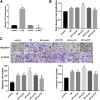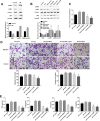LncRNA H19 induced by helicobacter pylori infection promotes gastric cancer cell growth via enhancing NF-κB-induced inflammation
- PMID: 31787851
- PMCID: PMC6878690
- DOI: 10.1186/s12950-019-0226-y
LncRNA H19 induced by helicobacter pylori infection promotes gastric cancer cell growth via enhancing NF-κB-induced inflammation
Abstract
Background: The aim of this study was to investigate the role of long non-coding RNA (lncRNA) H19 in gastric cancer (GC) with Helicobacter pylori (H. pylori).
Methods: H19 expression in peripheral blood from H. pylori+/- GC patients and healthy donors (control) as well as in GC tissues and cells were detected by qRT-PCR. Cell proliferation was evaluated by CCK-8 assay. Cell migration and invasion were evaluated by Transwell assay. The levels of pro-inflammatory cytokines were determined by ELISA. The protein levels of IκBα, p-IκBα and p65 were determined by western blotting.
Results: H19 expression was upregulated in H. pylori-infected GC tissues and cells. Furthermore, H. pylori promoted GC cell viability, migration, invasion and inflammatory response. Moreover, H19 overexpression promoted the proliferation, migration and invasion of H. pylori-infected GC cells via enhancing NF-κB-induced inflammation.
Conclusions: LncRNA H19 promotes H. pylori-induced GC cell growth via enhancing NF-κB-induced inflammation.
Keywords: Gastric cancer; H. pylori; H19; NF-κB signaling pathway.
© The Author(s). 2019.
Conflict of interest statement
Competing interestsThe authors declare that they have no competing interests.
Figures





Similar articles
-
Helicobacter pylori-induced aberrant demethylation and expression of GNB4 promotes gastric carcinogenesis via the Hippo-YAP1 pathway.BMC Med. 2023 Apr 5;21(1):134. doi: 10.1186/s12916-023-02842-6. BMC Med. 2023. PMID: 37016382 Free PMC article.
-
Helicobacter pylori-infected MSCs acquire a pro-inflammatory phenotype and induce human gastric cancer migration by promoting EMT in gastric cancer cells.Oncol Lett. 2016 Jan;11(1):449-457. doi: 10.3892/ol.2015.3897. Epub 2015 Nov 10. Oncol Lett. 2016. PMID: 26870232 Free PMC article.
-
A prominent role of LncRNA H19 in H. pylori CagA induced DNA damage response and cell malignancy.Sci Rep. 2024 Jun 20;14(1):14185. doi: 10.1038/s41598-024-65221-y. Sci Rep. 2024. PMID: 38902391 Free PMC article.
-
MiRNA-200c, MiRNA-139 and ln RNA H19; new predictors of treatment response in H-pylori- induced gastric ulcer or progression to gastric cancer.Microb Pathog. 2020 Dec;149:104442. doi: 10.1016/j.micpath.2020.104442. Epub 2020 Aug 11. Microb Pathog. 2020. PMID: 32795593
-
Detection and Treatment of Helicobacter pylori: Problems and Advances.Gastroenterol Res Pract. 2022 Oct 22;2022:4710964. doi: 10.1155/2022/4710964. eCollection 2022. Gastroenterol Res Pract. 2022. PMID: 36317106 Free PMC article. Review.
Cited by
-
Gastric Cancer Signaling Pathways and Therapeutic Applications.Technol Cancer Res Treat. 2024 Jan-Dec;23:15330338241271935. doi: 10.1177/15330338241271935. Technol Cancer Res Treat. 2024. PMID: 39376170 Free PMC article. Review.
-
The Antigastric Cancer Effect of Triptolide is Associated With H19/NF-κB/FLIP Axis.Front Pharmacol. 2022 Aug 30;13:918588. doi: 10.3389/fphar.2022.918588. eCollection 2022. Front Pharmacol. 2022. PMID: 36110523 Free PMC article.
-
Long non-coding RNAs: Biogenesis, functions, and clinical significance in gastric cancer.Mol Ther Oncolytics. 2021 Nov 11;23:458-476. doi: 10.1016/j.omto.2021.11.005. eCollection 2021 Dec 17. Mol Ther Oncolytics. 2021. PMID: 34901389 Free PMC article. Review.
-
Inhibition of lncRNA H19/miR-370-3p pathway mitigates neuronal apoptosis in an in vitro model of spinal cord injury (SCI).Transl Neurosci. 2021 Mar 1;12(1):103-113. doi: 10.1515/tnsci-2021-0013. eCollection 2021 Jan 1. Transl Neurosci. 2021. PMID: 33708438 Free PMC article.
-
Dysregulation of lncRNA in Helicobacter pylori-Infected Gastric Cancer Cells.Biomed Res Int. 2021 Jul 9;2021:6911734. doi: 10.1155/2021/6911734. eCollection 2021. Biomed Res Int. 2021. PMID: 34337048 Free PMC article. Review.
References
LinkOut - more resources
Full Text Sources
Miscellaneous

